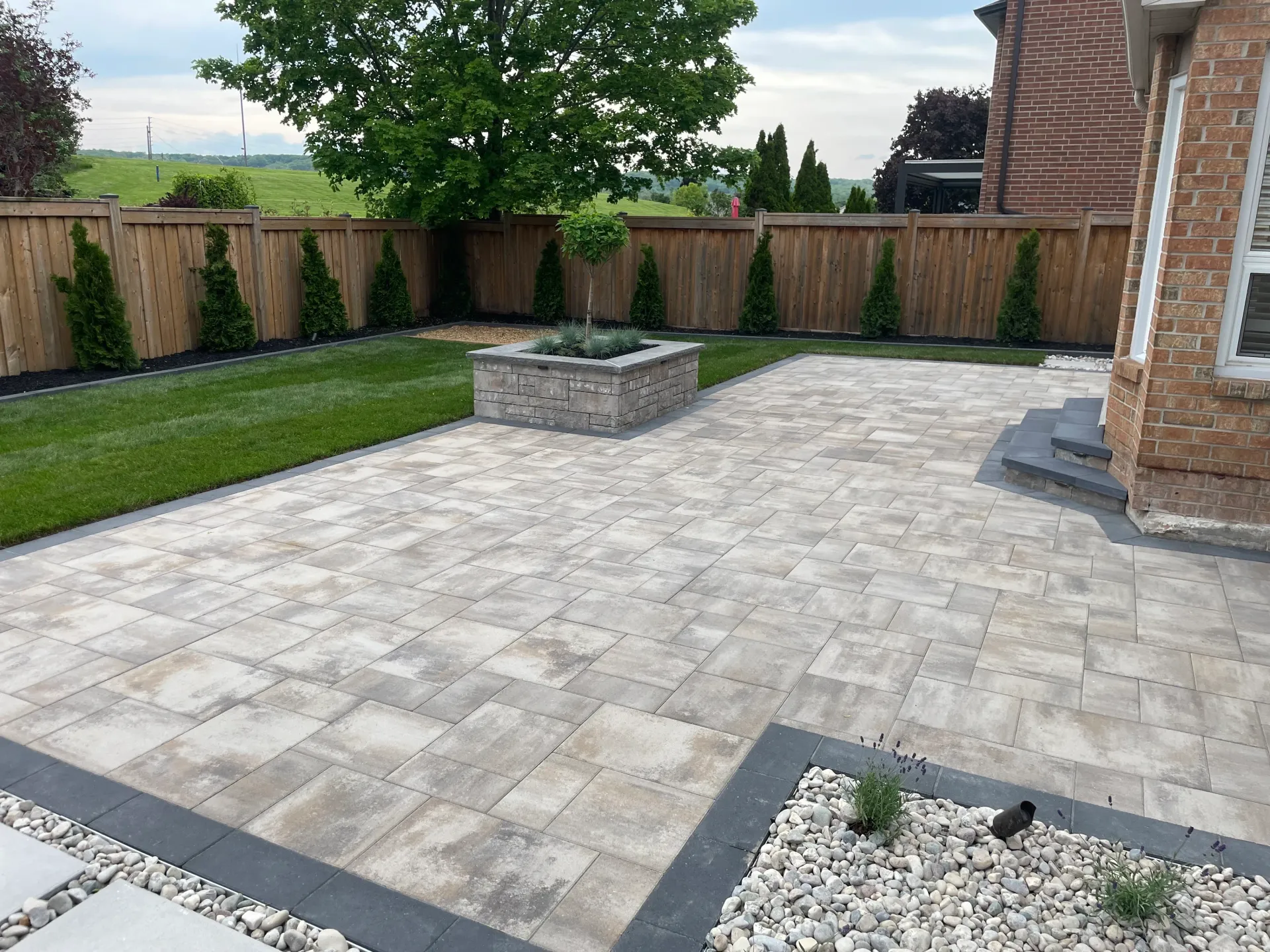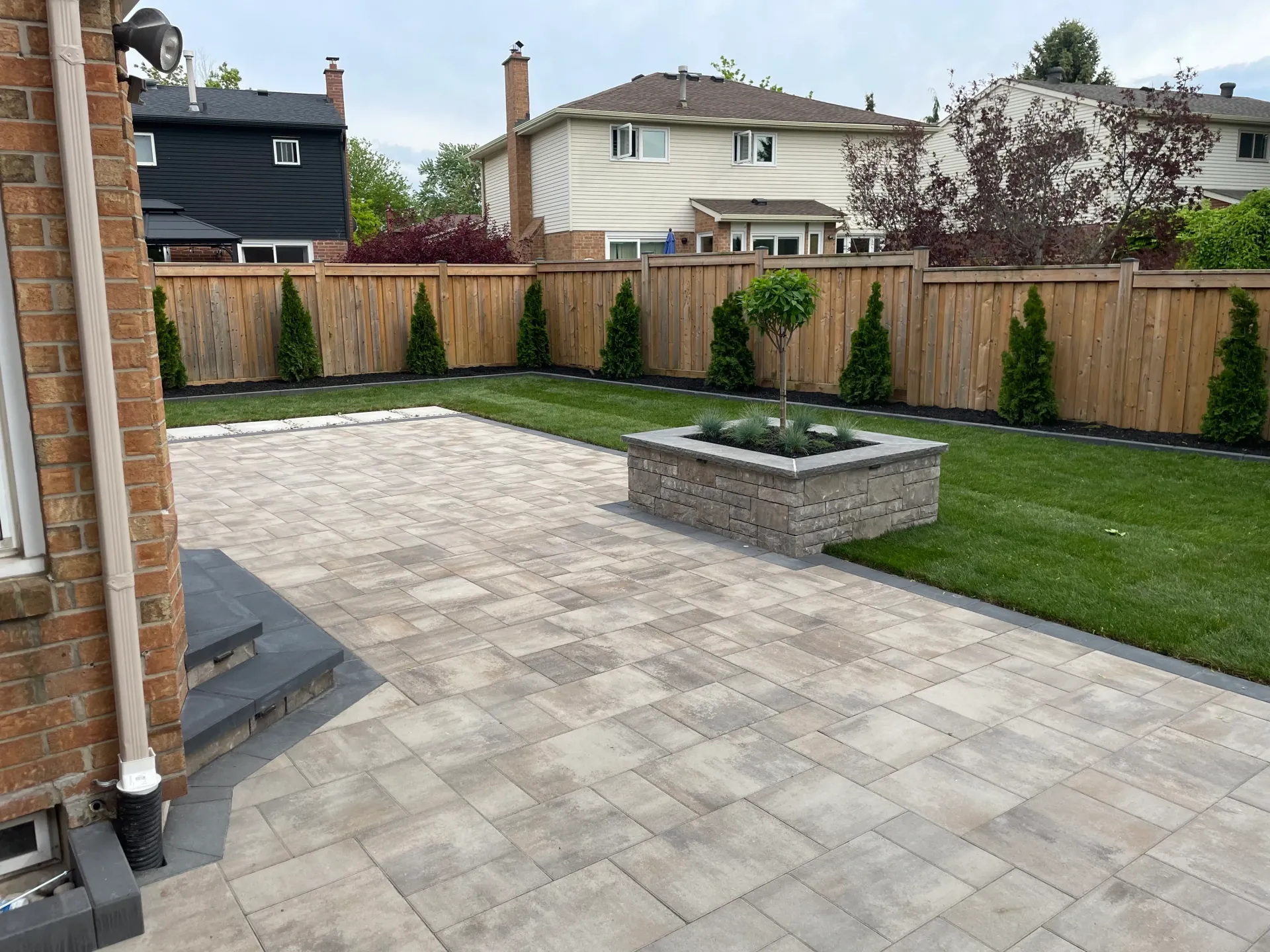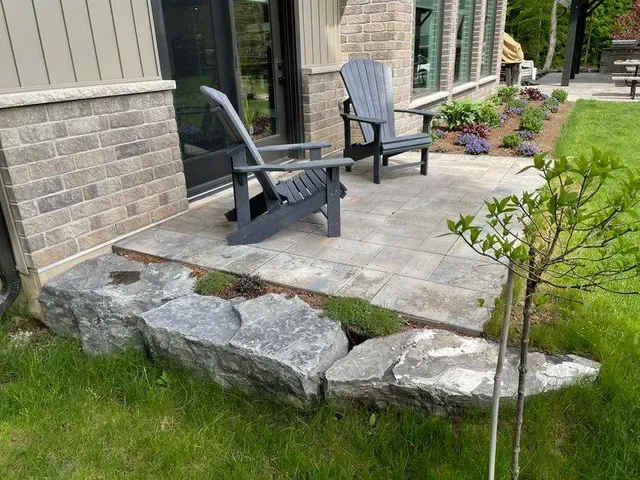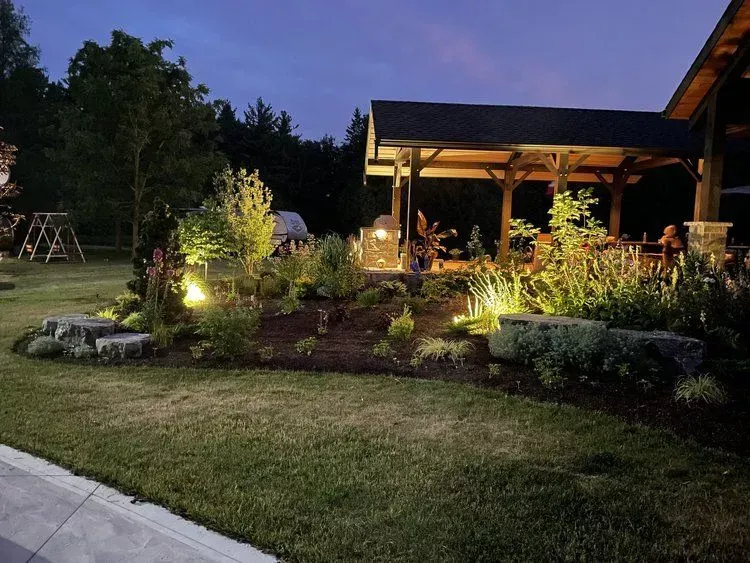Hardscape and Softscape: How To Blend Them Seamlessly

Introduction to Outdoor Space Design
Designing an outdoor space is a crucial aspect of creating a functional and aesthetically pleasing yard. A well-thought-out landscape design not only enhances the beauty of your property but also significantly boosts its curb appeal and overall value. At the heart of this design are two essential elements: hardscaping and softscaping.
Hardscape landscaping elements, such as patios, walkways, and retaining walls, provide the structure and definition needed to organize your outdoor space. These non-living elements create a framework that supports various activities and ensures durability under different weather conditions. On the other hand, softscaping elements, including plants, trees, and flowers, add softness and texture to your yard. They bring life, color, and a natural ambiance that makes the space inviting and serene.
By thoughtfully combining hardscaping and softscaping, you can create a harmonious and balanced landscape that meets your functional needs while enhancing the visual appeal of your property. Whether you’re aiming for a cozy backyard retreat or an elegant front yard, the right mix of these elements will help you achieve your vision.
Understanding the Roles of Hardscaping and Softscaping
Hardscaping provides structure, defines outdoor “rooms,” and ensures durability under foot and weather. A gazebo is a versatile structure that enhances outdoor living spaces. It includes materials such as natural stone, concrete pavers, wood decking, and metal edging. A pergola is another structure that provides shade and enhances outdoor living spaces. Hardscaping elements like a retaining wall can also be used to enhance patios and provide stability for sloped yards. An outdoor kitchen is a functional addition to hardscaping, offering amenities similar to those found indoors.
Softscaping, on the other hand, brings texture, color, and life through trees, shrubs, perennials, groundcovers, and turf. The façade of a home plays a crucial role in creating a harmonious balance between hardscape and softscape. Together, they establish balance: hardscape anchors the design, while softscape infuses it with seasonal interest and ecological benefits. Hardscaping elements are more permanent compared to softscaping elements, which can be changed frequently.
Neglecting either aspect can leave your yard feeling lopsided. A stone patio surrounded by bare earth feels incomplete, while a garden without pathways can seem unruly. Blending both disciplines creates a cohesive environment that’s both practical and beautiful. Understanding the difference between hardscape and softscape will help in maintaining the area once the design is completed.
Hardscaping Fundamentals
The choice of hardscaping materials depends on various factors, including the desired aesthetic, climate, and budget. Options range from natural stone, which offers a timeless and organic look, to manufactured concrete pavers that provide durability and versatility. Proper installation and maintenance of these hardscaping elements are essential to ensure their longevity and performance.
Hardscaping can also be used to create a variety of features that enhance the functionality and beauty of your yard. Outdoor kitchens, fire pits, and water features are popular additions that not only serve practical purposes but also become focal points in your landscape design. By carefully selecting and integrating these elements, you can create a cohesive and inviting outdoor space that meets your lifestyle needs.
Softscaping Essentials
The choice of softscaping elements depends on factors like climate, soil type, and the desired level of maintenance. For instance, low-maintenance grasses and groundcovers are ideal for those seeking an easy-to-care-for yard, while high-maintenance flower beds offer vibrant color and seasonal interest for gardening enthusiasts. Proper care and maintenance of softscaping elements are crucial to ensure their health and longevity. This includes regular watering, pruning, and fertilizing to keep plants thriving.
Softscaping can be used to create various features, such as gardens, meadows, and woodlands, that enhance the beauty and biodiversity of your yard. By thoughtfully selecting and arranging these living elements, you can create a dynamic and ever-changing landscape that provides year-round interest and enjoyment.
Start with a Unified Design Concept
Every successful outdoor project begins with a clear vision. Natural materials play a crucial role in creating an organic aesthetic in your outdoor space. Consider your lifestyle needs—do you entertain often? Do you need play areas for children?—and identify the “rooms” within your yard (dining, lounging, herb garden, fire pit, etc.). Examples of hardscaping elements include patios, walkways, and retaining walls, while softscaping elements include flowers, trees, and mulch.
Sketch a simple site plan that outlines where hardscape structures will sit in relation to planting areas. Be cautious of excessive hardscaping, as it can lead to a cold and sterile environment. Next, choose a consistent material palette. For instance, if your home features warm gray brick, select pavers or deck stain in complementary hues rather than clashing tones. Fences play a crucial role in defining boundaries and providing privacy. Coordinate metal fixtures (railings, fire pit surrounds) with outdoor furniture finishes.
Hardscaping materials like bricks, stone, and concrete should be chosen carefully to enhance both structure and aesthetic appeal. Softscape colors and textures—flowering perennials, evergreen shrubs, ornamental grasses—should echo or contrast these hard materials in a way that feels intentional. The style of your hardscape elements should reflect your unique tastes while ensuring a cohesive look throughout the design.
Transition Zones: The Key to Flow
Rather than abrupt edges where stone meets soil, create transition zones that ease the eye from one element to another. Structures like pergolas and gazebos can also be used in transition zones to enhance both functionality and aesthetics. A popular strategy is to incorporate a narrow planting strip filled with low-growing groundcovers (e.g., creeping thyme, sedum) between a patio and lawn. These living seams soften the hard edge and prevent soil erosion onto paved surfaces.
Step stones set within groundcover beds are another effective transition, inviting exploration and breaking up large swaths of hard material. Similarly, gravel pathways edged with native grasses provide a rustic transition from formal patios to informal garden areas. These subtle buffers encourage visual continuity and prevent hardscape from reading as “islands” in the landscape.
Material and Texture Synergy
When selecting stones, woods, or metals, look for textures and finishes that complement your plant palette. Hardscaping helps in creating a cohesive design by integrating various elements that enhance the overall aesthetic and functionality of the space. Rough-hewn flagstone pairs beautifully with billowy, loose-leaf perennials like Russian sage or ornamental grasses, creating a natural, “woodland” feel. Conversely, smooth, honed pavers and decks work well alongside clipped boxwood hedges or precise beds of succulents for a modern, minimalist aesthetic.
Pergolas can also play a significant role in enhancing outdoor spaces by providing both shade and an appealing focal point. Contrast also plays a role. Dark basalt pavers set off bright green ferns; bleached oak decking highlights rich burgundy foliage. Layer textures by mixing large-format pavers with smaller pebbles or decomposed granite in seating areas to echo the fine foliage of nearby ferns or sedges. Thoughtful pairing of hardscape elements and plant texture results in a dynamic, seamless environment.
Elevation and Level Changes
Integrating hardscape and softscape across slopes involves both function and beauty. The construction of retaining walls and terraces—constructed from natural stone or segmental block—can terrace a hill, creating flat planting beds for shrubs or flowers. Understanding the difference between hardscape and softscape elements is crucial for a cohesive design.
Recognizing the differences in elevation and level changes can assist in proper planning and design. Capstone seating walls serve double duty as outdoor benches and garden borders, establishing integrated zones that feel cohesive.
Stairs built from the same material as your patio, bordered by low plantings, guide visitors through grade changes while reinforcing the unity of design. Illuminating each step with low-voltage landscape lighting enhances safety and highlights the textures of both stone and foliage after dusk. Considering aesthetics in elevation changes ensures that the landscape is both functional and visually appealing.
Echoing Natural Patterns
Look to nature for inspiration in blending hard and soft elements. Planted elements can enhance natural patterns by adding greenery that softens the overall design. Notice how riverbeds combine smooth stones with sand, moss, and driftwood. Emulate those patterns with flagstone laid in irregular, organic shapes and planting pockets filled with water-tolerant groundcovers. Pavement, as an example of hardscaping materials, can provide a solid contrast to these softer elements. Various elements can be incorporated to mimic natural patterns, creating a cohesive and appealing outdoor space. In xeriscape gardens, group cacti and succulents among gravel beds, punctuated by sculptural boulders—this mimics arid landscapes where living and non-living features form harmonious communities.
Enhancing Curb Appeal
Curb appeal refers to the first impression a property makes on potential buyers or visitors, and it can be significantly enhanced through strategic landscaping and hardscaping. A well-designed outdoor space, featuring a beautifully landscaped yard and functional hardscape, can increase the value of your property and attract potential buyers.
Hardscaping elements, such as a decorative stone wall or a paved driveway, add a sense of elegance and sophistication to your property. These features provide structure and definition, making your yard look well-organized and inviting. Softscaping elements, including colorful flowers and lush greenery, add texture and depth, creating a natural and welcoming atmosphere.
A balanced combination of hardscaping and softscaping elements is key to creating a harmonious and beautiful outdoor space. By carefully selecting and integrating these elements, you can enhance the curb appeal of your property, making it more attractive to visitors and potential buyers alike.
Water Feature Integration
Water features, such as pools, ponds, and waterfalls, can add a sense of tranquility and relaxation to your yard. These features not only provide a soothing auditory experience but also become focal points that enhance the overall aesthetic of your outdoor space.
Hardscaping elements, such as stone or concrete, are often used to create water features, providing both functional and decorative elements. For example, a stone waterfall can serve as a stunning feature, while a concrete pond can create a serene retreat. Softscaping elements, including plants and trees, can be used to surround and enhance these water features, creating a natural and inviting atmosphere.
Integrating a water feature into your yard requires careful planning and design. Factors such as drainage, maintenance, and safety must be considered to ensure the feature functions properly and remains an asset to your landscape. A well-designed water feature can significantly enhance the beauty and functionality of your yard, creating a unique and inviting outdoor space that attracts visitors and increases the value of your property.
Seasonal Considerations and Maintenance
Even the most thoughtfully designed space requires care to retain its seamless look. Gates play a crucial role in maintaining privacy and security within your outdoor space. Keep planting beds trimmed so that foliage doesn’t encroach too heavily onto paved areas, and consider how a focal point, such as a fire pit, can enhance the visual appeal and create a designated area for gathering.
Periodically sweep or power-wash patios to remove debris that can soil plants or encourage moss growth. Replenish jointing sand between pavers to prevent weeds and maintain crisp lines. Grading is also essential to ensure proper layout and elevation of garden elements, contributing to both aesthetics and functionality.
Choose plants with staggered bloom times—spring bulbs, summer perennials, autumn grasses—to ensure color and texture year-round, and prune shrubs to maintain clear edges against hardscapes. Mulch planting strips annually to conserve moisture and prevent soil splash onto paved surfaces.
Bringing It All Together
Blending hardscaping with softscaping seamlessly elevates your outdoor living experience. Hardscaping helps in creating a cohesive design by structuring and enhancing outdoor spaces. By starting with a unified design concept, creating thoughtful transition zones, and selecting materials and plant textures that complement one another, you can craft a yard that feels both purposeful and organic. Incorporating decks as part of your hardscaping materials can significantly enhance the overall appeal and value of your home. Pergolas, along with other structures, add both functionality and aesthetics to outdoor spaces. Elevation changes, natural pattern echoes, and seasonal maintenance complete the picture, ensuring your space remains inviting in every season by integrating various hardscape elements.
For expert help integrating hard and soft elements in your landscape, contact Wilson Hardscape. Their team specializes in delivering cohesive designs and meticulous installations that turn backyards into unified, living works of art.




